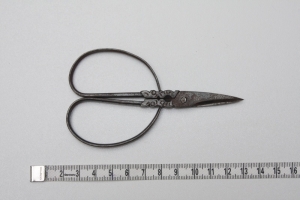Scissors consist of a pair of metal blades that are joined together at a pivot, mostly in the middle, whereby the sharpened parts of the blades below the pivot slide against each other when the upper parts of the blades, namely the handles or bows, are brought together.
The use of pivoted scissors was developed in medieval Europe and forms the basis of the wide range of scissors in use to the present day. It was not until the mid-eighteenth century, however, that scissors started to be produced on an industrial scale. By the nineteenth century, a wide variety of scissors was being exported from various European manufacturers around the world. There are various types of scissors associated with decorative needlework, such as embroidery scissors, which are small scissors with long, thin blades; cutting out scissors that have one rounded and one straight blade, as well as buttonhole scissors and lace scissors.
Sources:
- CLABBURN, Pamela (1976). The Needleworker’s Dictionary, London: Macmillan London Ltd, p. 235.
- Shorter Oxford English Dictionary: ‘Scissors’
GVE

